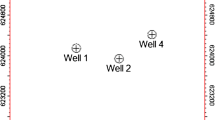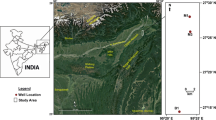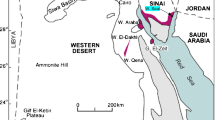Abstract
This study is aimed at enhancing characterization of deepwater reservoir sands as a way of de-risking the exploration prospect in “N” field. The data used for the analysis consist of logs from suites of four wells. The petrophysical analysis of the two reservoirs (RES-1 and RES-2) of interest revealed that reservoir (RES-1) has fair to good petrophysical attributes while reservoir (RES-2) has good to excellent petrophysical attributes. Statistical relationships between compressional and shear velocity (Vp and Vs) were evaluated from dipole sonic log present in N-002 well using linear regression analysis. This localized relation with a correlation coefficient of 0.96 predicts VS from VP with high level of precision and fits a large population analysis of the wells. Compaction studies revealed that at depth of 3.2 km, quartz cementation of sands and velocity of sandstones became higher than that of shales. This depth represents a transition from mechanical to chemical compaction zone and therefore represents a significant seismic boundary in the studied field. Porosity-velocity crossplot of the reservoir sands revealed that only reservoir sand data points which contained 30 to 40% porosity plunge across the 15% clay line with most data points falling between 0.25 and 0.35 fraction and below 0.35 clay trend lines. This suggest high clay fraction within the sediments. Rock physics templates of constant, contact and friable showed that the reservoir sands are poorly cemented to unconsolidated. The two models indicate that the reservoir sands are both influenced by depositional and depth related diagenetic effects. This suggests that proper care has to be taken during the development of these reservoir sands due to high clay fraction which could affect oil and gas production.









Similar content being viewed by others
Change history
22 February 2022
A Correction to this paper has been published: https://doi.org/10.1007/s12517-022-09697-w
References
Abe JS, Edigbue PI, Lawrence SG (2018) Rock physics analysis and Gassmann’s fluid substitution for reservoir characterization of ‘BG’ field, Niger Delta. Arab J Geosci 656:1–11
Asquith, G. B. and Gibson C. R. (1982). Basic well log analysis: AAPG Methods in Exploration Series, AAPG Tusla, Oklahoma, pp 120–150.
Avbovbo AA (1978) Tertiary lithostratigraphy of Niger Delta. Am Assoc Pet Geol Bull 62:295–300
Avseth P, Flesche H, Van Wijngaarden AJ (2003) AVO classification of lithology and pore fluids constrained by rock physics depth trend. Lead Edge 22:1004–1011
Avseth, P. (2010). Exploration rock physics the link between geological processes and geophysical observables (Chapter 18), Petroleum Geoscience by Bjørlykke K.: From Sedimentary Environments to Rock Physics, pp 403–426.
Avseth P, Mukerji T, Mavko G (2005) Quantitative seismic interpretation: applying rock physics tools to reduce interpretation risk. Cambridge University Press, Cambridge
Batzle ML, Wang Z (1992) Seismic properties of pore fluids. Geophysics 57:1396–1408
Castagna JP, Batzle ML, Eastwood RL (1985) Relationships between compressional-wave and shear-wave velocities in clastic silicate rocks. Geophysics 50(4):571–581
Chapman M. (2008). Nonlinear seismic response of rock saturated with multiple fluids. SEG Annual Meeting Abstract.
Doust, H., and Omatsola, E. (1990). Niger Delta, in, Edwards, J. D., and Santogrossi, P.A., eds., Divergent/passive Margin Basins: AAPG Memoir 48: Tulsa, American Association of Petroleum Geologists, pp 239–248.
Dvorkin J, Nur A (1996) Elasticity of high-porosity sandstones theory for two north sea data sets. Rock Physics Laboratory, Department of Geophysics, Stanford University. Stanford, California Geophysics 61(5):1363–1370
Gassmann F (1951) Elastic waves through a packing of spheres. American Geological Institute 13(10):1–23
Han D, Nur A, Morgan D (1986) Effect of porosity and clay content on the wave velocities in sandstones. Geophysics 51(11):2093–2107
Hashin Z, Shtrikman S (1963) A variational approach to the theory of the elastic behaviour of polycrystals. J Mech Phys Solids 10:343–352
Kaplan, A., Lusser, C. U. and Norton, I. O. (1994). Tectonic map of the world, panel 10: Tulsa, American Association of Petroleum Geologists, scale 1:10,000,000.
Klett, T.R., Ahlbrandt, T.S., Schmoker, J.W., and Dolton, J.L. (997). Ranking of the world’s oil and gas provinces by known petroleum volumes: U.S. Geological Survey Open-file Report-97–463, CD-ROM.
Kulke, H. (1995). Regional petroleum geology of the world. Part II: Africa, America, Australia and Antarctica: Berlin, Gebrüder Borntraeger, pp 143–172.
Lander RH, Walderhaug O (1999) Predicting Porosity through Simulating Sandstone Compaction and Quartz Cementation. Am Assoc Pet Geol Bull 83:433–449
Larionov WW (1969) Borehole radiometry. Nedra, Moscow, pp 127–130
Lewis, J., Clinch S., Meyer D., Richards M., Skirius C., Stokes R., and Zarra L. (2008). Exploration and appraisal challenges in the gulf of Mexico deep water Wilcox: part - exploration overview, reservoir quality, and seismic imaging. Chevron North America Exploration and Production Company. pp 398–414.
Marion, D. (1990) Acoustical, mechanical and transport properties of sediments and granular materials. Ph.D.-thesis.
Mavko, G., Mukerji, T. and Dvorkin, J. (1998). The rock physics handbook: tools for seismic analysis in porous media: Cambridge University Press.
Mindlin RD (1949) Compliance of elastic bodies in contact. J. Appl. Mech 16:259–268
Petroconsultants (1996a). Petroleum exploration and production database: Houston, Texas, Petroconsultants, Inc., [database available from Petroconsultants, Inc., P.O. Box 740619, Houston, TX 77274–0619].
Pettingill, G. (1998). Turbidite giants - lessons from the world’s 40 largest turbidite discoveries: EAGE/AAPG 3rd research symposium on developing and managing turbidite reservoirs, Almeria, expanded abstracts, A027.
Rider M (1986) The geological interpretation of well logs. Blackie, Glasgow, pp 151–165
Weber KJ, Daukoru E (1975) Petroleum geology of the Niger Delta. Proceedings of the Ninth World Petroleum Congress 2:209–221
Williams, D. M. (1990). “The acoustic log hydrocarbon indicator.” Society of Petrophysicists and Well Log Analysts, 31st Logging Symposium.
Yin, H. (1992). Acoustic velocity and attenuation of rocks: isotropy, intrinsic anisotropy and stress induced anisotropy. PhD thesis, Stanford University.
Author information
Authors and Affiliations
Corresponding author
Additional information
Responsible Editor: Narasimman Sundararajan
The original online version of this article was revised: In this article the author names were incorrectly given as “Akinyemi, Oluwaseun Daniel, Ayuk, Michael Ayuk” but should have been “Oluwaseun Daniel Akinyemi, Michael Ayuk Ayuk”.
Rights and permissions
About this article
Cite this article
Akinyemi, O.D., Ayuk, M.A. Rock physics analysis as a tool for enhancing characterization of Niger Delta deep water sands. Arab J Geosci 15, 98 (2022). https://doi.org/10.1007/s12517-021-09370-8
Received:
Accepted:
Published:
DOI: https://doi.org/10.1007/s12517-021-09370-8




